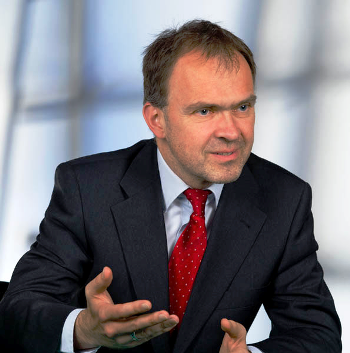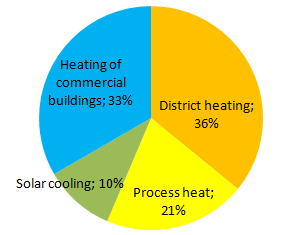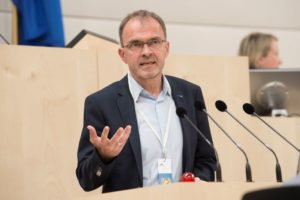Austria Solar: ”It’s about faster and simpler access to solar systems”
December 14, 2016
 In September 2016, Roger Hackstock returned as Managing Director of Austria Solar after having already occupied this position between 2002 and 2013. In the three years that he was not at the helm of the Austrian industry association, Hackstock published a book on the “Energiewende” (energy transition), worked as programme manager for the country’s Climate and Energy Fund and coordinated the Storage initiative as an independent consultant. During our interview, he spoke about the challenges solar heat has had to face over the years, as market demand for system solutions is steadily on the rise, and noted that he was happy to support the industry in this new era.
In September 2016, Roger Hackstock returned as Managing Director of Austria Solar after having already occupied this position between 2002 and 2013. In the three years that he was not at the helm of the Austrian industry association, Hackstock published a book on the “Energiewende” (energy transition), worked as programme manager for the country’s Climate and Energy Fund and coordinated the Storage initiative as an independent consultant. During our interview, he spoke about the challenges solar heat has had to face over the years, as market demand for system solutions is steadily on the rise, and noted that he was happy to support the industry in this new era.Solarthermalworld.org: After three years, you returned to Austria Solar. Have you noticed any changes on the domestic solar thermal market?
Hackstock: The market has contracted dramatically, in particular in the single-family home segment. Customers enjoy a great many options nowadays and that means often enough that they decide on a heat pump instead. Right now, it looks as if only people who are absolutely convinced of the benefits of solar heat purchase systems from installers committed to the cause. These installers may make up 1 % of all companies in the field; the others have simply lost their appetite for the technology. Many suppliers have responded to this change by adding heat pump and PV solutions to their product portfolio. One company (Siko) has even dropped “solar” from its name. The senior managing director, Arthur Sief, explained it in this way: When people look for a heating system, we offer them a product. This product may be equipped with a small solar thermal unit, but we focus on providing a system heating solution.
Solarthermalworld.org: How will you adapt your strategy in support of the industry?
Hackstock: I have made it very clear to the board that I intend to work closely with our association members and that they themselves need to provide some input. Hence, I have talked to them throughout the past weeks and have asked them: Where do you see yourself in five years? What products are needed on the market? What do you think are the strengths of solar thermal and where do you see the challenges?
Solarthermalworld.org: And the conclusions you have been able to draw from your initial conversations?
Hackstock: The industry is at a crossroads and it must decide how it wants to proceed. Solar thermal providers can continue with business as usual, which means they will supply an environmentally conscious customer base the size of what we had had before 2000. Or they can take a proactive approach and talk to customers without the middleman, use the web to attract new prospects, examine which systems were to benefit economically from solar thermal and offer only integrated solutions.
In short: It’s about giving people faster and simpler access to the solar heating system they require. A survey among customers, planners, architects and installers has shown that the industry is making it rather difficult for consumers to obtain a solar thermal system. This needs to change completely.
Solarthermalworld.org: Which new and economically feasible system solutions are you thinking of?
Hackstock: One of them is a fully solar-heated building either residential or commercial. The idea behind it is to view the building itself as storage space. Heat exchanger manifolds will already be integrated into the ceiling of each floor when the structural work is being done.
The cement industry has shown great interest in this new approach. The Association of the Austrian Cement Industry, whose members have a 95 % market share in ceiling installations in Austria, has published guidelines on the thermal activation of building components and has planned a pilot project encompassing three residential buildings. One of them has already been in use. This building is warmed up by a heat pump and excess wind power; the other two are equipped with a heat pump each and either a PV or a solar thermal system. In all three buildings, the ceilings of each floor are used as heat storage to maintain comfortable temperature levels inside the rooms. First simulations show that a structure heated up to e.g. 26 °C will only cool by 0.5 to 1 °C per day – even in wintertime when it is -10 °C outside and even if the heating system gets no sun over days.
Combinations of solar thermal and heat pump often result in the latter regenerating the underground storage or improving the COP of the former. You can also use PVT elements, which achieve satisfactory results. Temperatures between 40 and 60 °C are enough for the heat pump and will still lead to more than 300 kWh/m²a, as shown by a Swiss pilot project at multi-family properties.
Solarthermalworld.org: In Germany, it is Berlin-based start-up Thermondo which is disrupting the market. Is that a possible avenue for you?
Hackstock: Thermondo shows that you can actually offer heating systems online without first having to meet with the customer on site. Within three years, the start-up has grown into a 220-staff business that has sold more than 3,000 heating systems, 250 of which were equipped with solar thermal technology. Austrian stakeholders have taken note, but our installer association at federal level has warned against launching this kind of business here. They have very conservative views about these kinds of endeavours.
The subject has also come up in our internal discussions and we are trying to determine which elements of it could become part of sales strategies in Austria. Obviously, this will take some courage to implement, as it means breaking a strict taboo in a country which has had a two- to three-tier distribution channel. But some in the industry may soon have had enough and decide to act, as they are growing extremely impatient with the market’s dwindling numbers year after year.
The interview was conducted in German by Bärbel Epp and was translated by Björn Vrooman.
Websites of associations mentioned in this article:


